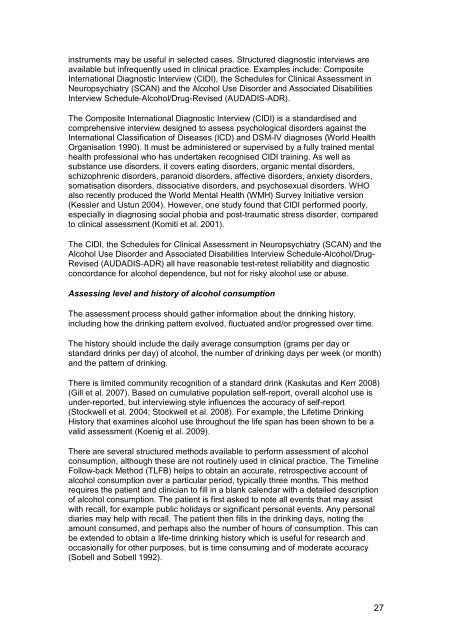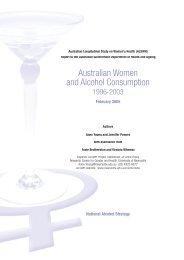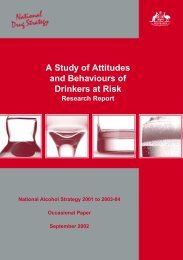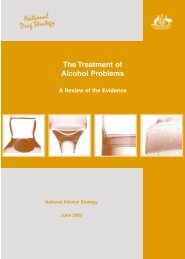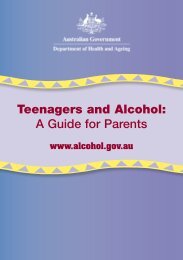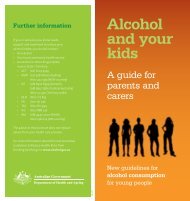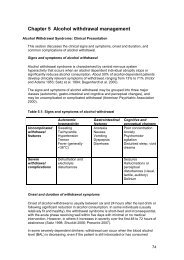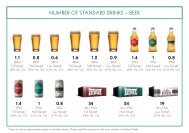Chapter 3 Screening, assessment and treatment planning - Alcohol
Chapter 3 Screening, assessment and treatment planning - Alcohol
Chapter 3 Screening, assessment and treatment planning - Alcohol
Create successful ePaper yourself
Turn your PDF publications into a flip-book with our unique Google optimized e-Paper software.
instruments may be useful in selected cases. Structured diagnostic interviews areavailable but infrequently used in clinical practice. Examples include: CompositeInternational Diagnostic Interview (CIDI), the Schedules for Clinical Assessment inNeuropsychiatry (SCAN) <strong>and</strong> the <strong>Alcohol</strong> Use Disorder <strong>and</strong> Associated DisabilitiesInterview Schedule-<strong>Alcohol</strong>/Drug-Revised (AUDADIS-ADR).The Composite International Diagnostic Interview (CIDI) is a st<strong>and</strong>ardised <strong>and</strong>comprehensive interview designed to assess psychological disorders against theInternational Classification of Diseases (ICD) <strong>and</strong> DSM-IV diagnoses (World HealthOrganisation 1990). It must be administered or supervised by a fully trained mentalhealth professional who has undertaken recognised CIDI training. As well assubstance use disorders, it covers eating disorders, organic mental disorders,schizophrenic disorders, paranoid disorders, affective disorders, anxiety disorders,somatisation disorders, dissociative disorders, <strong>and</strong> psychosexual disorders. WHOalso recently produced the World Mental Health (WMH) Survey Initiative version(Kessler <strong>and</strong> Ustun 2004). However, one study found that CIDI performed poorly,especially in diagnosing social phobia <strong>and</strong> post-traumatic stress disorder, comparedto clinical <strong>assessment</strong> (Komiti et al. 2001).The CIDI, the Schedules for Clinical Assessment in Neuropsychiatry (SCAN) <strong>and</strong> the<strong>Alcohol</strong> Use Disorder <strong>and</strong> Associated Disabilities Interview Schedule-<strong>Alcohol</strong>/Drug-Revised (AUDADIS-ADR) all have reasonable test-retest reliability <strong>and</strong> diagnosticconcordance for alcohol dependence, but not for risky alcohol use or abuse.Assessing level <strong>and</strong> history of alcohol consumptionThe <strong>assessment</strong> process should gather information about the drinking history,including how the drinking pattern evolved, fluctuated <strong>and</strong>/or progressed over time.The history should include the daily average consumption (grams per day orst<strong>and</strong>ard drinks per day) of alcohol, the number of drinking days per week (or month)<strong>and</strong> the pattern of drinking.There is limited community recognition of a st<strong>and</strong>ard drink (Kaskutas <strong>and</strong> Kerr 2008)(Gill et al. 2007). Based on cumulative population self-report, overall alcohol use isunder-reported, but interviewing style influences the accuracy of self-report(Stockwell et al. 2004; Stockwell et al. 2008). For example, the Lifetime DrinkingHistory that examines alcohol use throughout the life span has been shown to be avalid <strong>assessment</strong> (Koenig et al. 2009).There are several structured methods available to perform <strong>assessment</strong> of alcoholconsumption, although these are not routinely used in clinical practice. The TimelineFollow-back Method (TLFB) helps to obtain an accurate, retrospective account ofalcohol consumption over a particular period, typically three months. This methodrequires the patient <strong>and</strong> clinician to fill in a blank calendar with a detailed descriptionof alcohol consumption. The patient is first asked to note all events that may assistwith recall, for example public holidays or significant personal events. Any personaldiaries may help with recall. The patient then fills in the drinking days, noting theamount consumed, <strong>and</strong> perhaps also the number of hours of consumption. This canbe extended to obtain a life-time drinking history which is useful for research <strong>and</strong>occasionally for other purposes, but is time consuming <strong>and</strong> of moderate accuracy(Sobell <strong>and</strong> Sobell 1992).27


